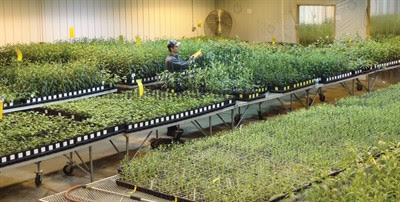Archangel Ancient Tree Archive
Meet David Milarch- a man who has undertaken a gargantuan and what some scientists and foresters
had told him was an impossible task. He is collecting genetic samples of the oldest, largest trees on Earth.
had told him was an impossible task. He is collecting genetic samples of the oldest, largest trees on Earth.
He and his sons are then doing the near impossible-they are propagating and growing these trees
out and creating a champion tree archive. David is creating a Noah's Ark of the world's oldest, largest
and most famous trees.
David Milarch
Now for an interesting twist and some background information.
David Milarch is a third generation nurseryman. He used to live a wild life, he rode with motorcycle gangs,
drank and partied hard. An alcoholic for many years, he eventually suffered organ shutdown/renal failure.As he lay dying with his family around him, he had a life changing near-death experience.
David had an out of body experience with what he described as "angels" He was escorted by 2 angels
to another place, a place of pure light. He could see a shimmering city in the distance and he badly wanted to go there. He said he felt so much love and pure bliss, he never wanted to leave.
He was confronted by a giant Angel (archangel)? who told him he could not stay. " you must go back, you still have work to do" the giant angel told him. He returned to his own body, sat up in bed
and told his family he was not going to die and he didn't. He recovered over the course of several months and waited for a sign of what he was supposed to do. He said an angel returned one night-His bedroom was full of golden light and he was instructed to take paper and pen and go to another room. He did as instructed and when he awoke later,his pad was full of notes-This is part of what he had written:
The Earth's trees and forests were dying. Diseases, insects, drought and other
factors were decimating the natural order of things.The Earth and it's people were in danger.
David was commanded by the angel to clone the biggest, oldest and hardiest trees in the world. Trees that had lived hundreds and thousands of years.
David was commanded by the angel to clone the biggest, oldest and hardiest trees in the world. Trees that had lived hundreds and thousands of years.
The Earth and it's trees could only be fully restored to their natural order by planting trees grown from the giants of the forest.
David started the Archangel champion tree project in 1996 with his 2 sons, Jared and Jake.
They initially cloned a champion Sugar Maple and have not looked back.
Since then, they have propagated over 45 species of trees. Just to name a few:
Coast Redwood-multiple trees/champions
Giant Sequoia-cloned 5th largest Sequoia in the world and other champions
Champion Oaks of Ireland and Britain
Bristlecone Pine-they cloned the Methuselah tree! The oldest single tree in the world.
Bristlecone Pine-they cloned the Methuselah tree! The oldest single tree in the world.
Willow
Yew
The Archangel group has taken DNA from 60 of the most magnificent trees on the planet. They have cloned thousands of trees from this original DNA and are actively re-planting/re-foresting these champion trees.
This group of dedicated people did what the experts said was impossible.
Because of the cyclical nature of their work, they take cuttings from ancient trees only part of the time.. Because every species is different, they have to find which method of propagation will work for each tree. It takes time to nurture and grow out propagated seedlings in their labs.
Clonal propagation of old growth trees at Archangel facility (location is a well guarded secret)
Jared Milarch getting DNA from the Waterfall Tree-Giant Sequoia
Meryl Marsh-Archangel Global Field Coordinator-Pictured with 5th largest tree in the world, Giant Sequoia
The Archangel Mission:
To propagate the world's most important old growth trees before they are gone.
To reforest the Earth with the offspring of these trees.
To archive the genetics of ancient trees in living libraries around the world for the future.
Whether you believe in the story of angelic guidance or not,
this is still an amazing story of one man's vision and the willpower to make it happen.
To read more about this story go to: www.ancienttreearchive.org
There is a book written about David Millard. "The Man Who Planted Trees", by Jim Robbins.


















